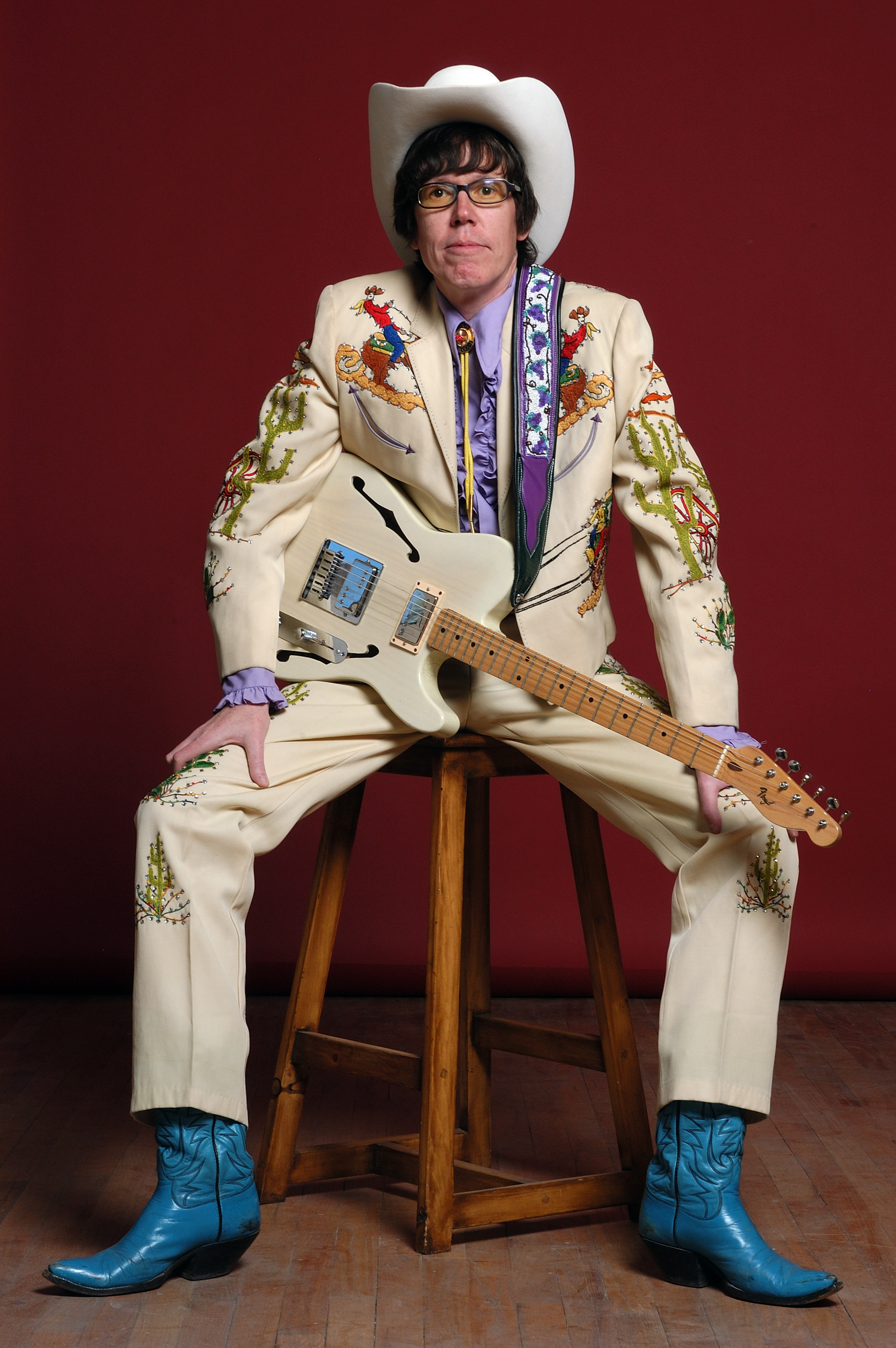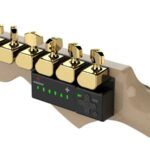Kenny Vaughan stands as a prominent figure in the vibrant Nashville music scene, celebrated for his exceptional guitar skills and versatile musicality. His unique style blends the raw energy of rock and roll with the deep-rooted traditions of country and blues, making him a sought-after guitarist by artists ranging from Lucinda Williams to Marty Stuart. This exploration delves into the influences, gear, and career of Kenny Vaughan, revealing what makes his guitar playing so distinctive and admired.
 Kenny Vaughan with Floyd Tele
Kenny Vaughan with Floyd Tele
Image: Kenny Vaughan showcasing his signature Floyd Telecaster guitar, highlighting his preferred instrument for achieving his distinctive sound.
Early Influences and Musical Awakening
Born just outside of Denver, Colorado, Kenny Vaughan’s journey into guitar playing began at the age of ten, sparked by a pivotal moment: watching The Beatles on the Ed Sullivan Show. This initial fascination quickly evolved into a serious pursuit, fueled by his father’s extensive jazz record collection. His father, recognizing Kenny’s burgeoning interest, took him to witness jazz guitar legend Johnny Smith perform live, instilling in him an early appreciation for masterful guitar technique.
Vaughan’s first guitar was a brand new 1966 Telecaster, purchased directly from Johnny Smith himself at the age of twelve. He commenced formal lessons, but it was the electrifying sounds of the British Invasion that truly ignited his passion. 1966, a golden year for rock and roll, provided Vaughan with a rich tapestry of influences. Bands like The Animals and The Kinks captured his attention, but it was The Yardbirds, particularly with Jeff Beck on guitar, that profoundly impacted him. Hearing “Having A Rave Up With The Yardbirds” and witnessing Beck’s innovative and sometimes destructive playing style on television shows like Shindig! solidified Vaughan’s determination to explore the expressive possibilities of the electric guitar. He recognized echoes of Les Paul’s pioneering sounds in Beck’s playing, further broadening his musical horizons.
Embracing Country Roots and Expanding Horizons
While immersed in the rock and roll explosion of the 60s, Vaughan also discovered the compelling sounds of country music. A neighbor introduced him to the music of Buck Owens, Johnny Cash, and Merle Haggard, exposing him to the foundational twang and storytelling of country legends. The first song he learned to play on his Telecaster was Johnny Cash’s “Folsom Prison Blues,” a testament to the early integration of country influences into his evolving guitar style.
The late 1960s brought further transformative musical experiences. Seeing Jimi Hendrix live in 1968 expanded Vaughan’s understanding of guitar sonics, leading him to experiment with fuzz tones and explore the boundaries of electric guitar expression. He also witnessed iconic performances by Cream, Howlin’ Wolf, Mike Bloomfield with the Butterfield Blues Band, and even Led Zeppelin’s first US performance, absorbing a diverse spectrum of blues, rock, and groundbreaking guitar techniques.
The fusion trend of the 1970s didn’t resonate with Vaughan. Instead, he gravitated towards the raw energy of artists like Iggy Pop and found a mentor in guitarist Bill Frisell while working at a local music store. Frisell helped Vaughan deepen his understanding of the guitar fretboard and encouraged him to explore beyond conventional jazz standards, fostering a spirit of musical exploration that continues to define Vaughan’s approach.
Nashville Calling: A Career in Music City
Despite his diverse influences, Vaughan began his professional playing career in country music. While some of his peers sought predictable gigs playing in uniform at Holiday Inns, Vaughan chose a different path, immersing himself in the honky-tonk scene. He played with seasoned musicians who favored Telecasters through Fender Twin Reverbs, learning the nuances of traditional country guitar tones while adding his own “weirdo punk rock kid” edge to the mix. Simultaneously, he explored his punk rock inclinations in a separate band, showcasing his versatility even in his early career.
A pivotal call in 1985 led Vaughan to Nashville as a fill-in guitarist. This temporary gig turned permanent, and Vaughan never returned to Denver. Nashville became his musical home, and he quickly established himself as a sought-after player.
His early professional gigs in Nashville included playing with Sweethearts of the Rodeo, followed by collaborations with Patty Loveless, Rodney Crowell, and Kim Richey. After touring, Vaughan transitioned into session work, further honing his skills and versatility in the studio environment. A significant touring opportunity arose with Lucinda Williams, with whom he played for three years before returning to the thriving Nashville session scene.
Kenny Vaughan’s Coveted Guitar Gear
Kenny Vaughan’s move to Nashville was accompanied by a collection of prized vintage gear, including a 1963 Esquire, a 1966 Stratocaster, a mid-1960s Vox AC30 top boost, and a Tweed Pro amp. Adding to his arsenal, he acquired a blackface Fender Twin when he started playing with Patty Loveless. During this period, he also began incorporating G&L and Music Man guitars into his setup, particularly favoring his G&L ASAT and Music Man Albert Lee models, which remain staples in his collection.
A significant turning point in Vaughan’s guitar journey was his discovery of Floyd guitars. While playing in downtown Nashville, guitarist Don Kelly introduced him to these instruments, famously telling him to “get rid of that piece of junk and play a real guitar.” Vaughan acquired a Floyd guitar from Kelly and has been a dedicated player ever since. His Floyd collection includes a green thinline with a Bigsby tremolo and a baritone model, and he recently acquired a cream-colored Floyd equipped with custom Lindy Fralin pickups.
When performing live with Marty Stuart, Kenny Vaughan’s amp setup typically features a 1964 Vibroverb and a 1965 Showman with a 15-inch speaker. He also utilizes a custom-built amp by Ky Kennedy, based on a late 1950s Fender Twin, recognizable by its red color and “Big Jo” grill cloth. This “Big Jo” amp sees frequent use at the Grand Ole Opry and local Nashville club gigs. For higher-gain tones, Vaughan employs a 50-watt Naylor 4×12 amplifier and has explored newer amp models like the Peavey Penta.
In the studio, Vaughan’s amp choices expand to include a 1966 Fender Deluxe, a Princeton, a 1971 Marshall PA 20, and a Dr. Z Carmen Ghia head, often paired with a Vox AC30 cabinet loaded with Celestion Vintage 30 speakers. He discovered Dr. Z amps through a chance encounter in Cleveland, where Dr. Z himself brought amps for Vaughan to try.
Beyond his core guitars, Vaughan’s studio collection is diverse, featuring a custom shop Les Paul with Lindy Fralin pickups, a Harmony guitar strung with flatwound strings, a Hagstrom with a whammy bar, a 1959 Meteor, and a Teisco Spectrum 4. He appreciates the unique tonal qualities of older Harmony guitars with flatwounds, often blending them with the brighter sounds of modern guitars with round wound strings. His collection also includes a vintage Gretsch and a Guild X175, further showcasing his appreciation for a wide range of guitar tones. The Music Man Albert Lee model, which he likens to a high-quality hardtail Stratocaster, also remains a favorite.
For pedals, Vaughan favors a Dallas Rangemaster treble booster with his Marshall amp, crucial for pushing the amp’s front end while maintaining its characteristic attack. He also uses an MXR Micro Amp to boost single-coil pickups into Fender amps. While he owns a vintage Fuzz Face, he finds it finicky and prefers the Captain Coconut for fuzz effects reminiscent of Jimi Hendrix. Interestingly, Vaughan notes that he could manage almost any gig with just a Boss Blues Driver and a Boss Delay, highlighting his ability to achieve great tone with even basic effects.
The Hallmarks of Kenny Vaughan’s Guitar Style
Kenny Vaughan’s guitar playing is characterized by a potent blend of tone, technique, and an undeniable “vibe.” He delivers his grooves with panache, drawing from a vast well of influences. He cites seeing Jeff Beck with The Yardbirds as an early and significant influence, equally impactful as hearing the foundational country twang of Luther Perkins, Johnny Cash’s legendary guitarist. His playing reflects a deep absorption of diverse guitar styles, ranging from Jimi Hendrix’s revolutionary sounds to the nuanced jazz stylings of Bill Frisell and the under-appreciated blues mastery of Hollywood Fats.
Vaughan’s appreciation extends to classic country guitarists like Roy Latham, whose playing he admires deeply. He considers Hollywood Fats’ version of “Okie Dokie Stomp” definitive and holds Jimmy Bryant and Roy Nichols in high regard. He particularly praises Roy Nichols, Merle Haggard’s guitarist, as the quintessential country player of the 1970s, noting his ability to blend intricate licks with jazz-influenced chord voicings.
Looking towards contemporary players, Vaughan highlights James Mitchell and Guthrie Trapp as standouts in the Nashville scene. He marvels at James Mitchell’s ability to seamlessly weave Brent Mason-esque country licks with sophisticated Lenny Breau-inspired jazz phrasing. He also recognizes Guthrie Trapp as a fellow devotee of the Hollywood Fats style and a phenomenal guitarist in his own right.
Kenny Vaughan’s career and playing style exemplify a deep respect for guitar history combined with a forward-thinking approach to musical expression. His ability to navigate diverse genres and deliver consistently compelling performances has solidified his place as a true guitar master in Nashville and beyond.

